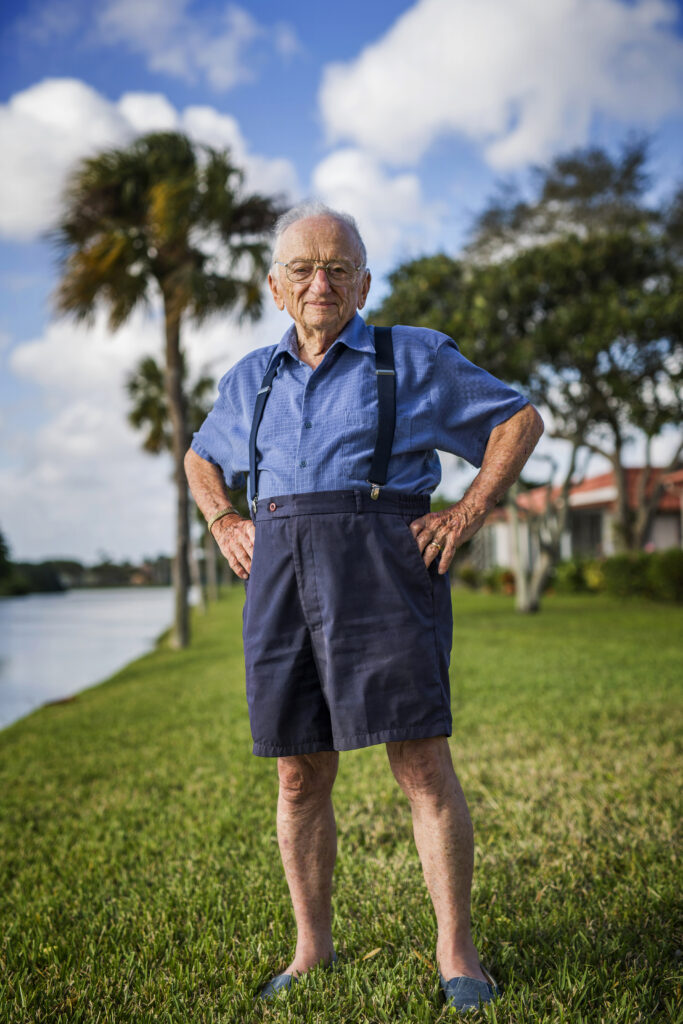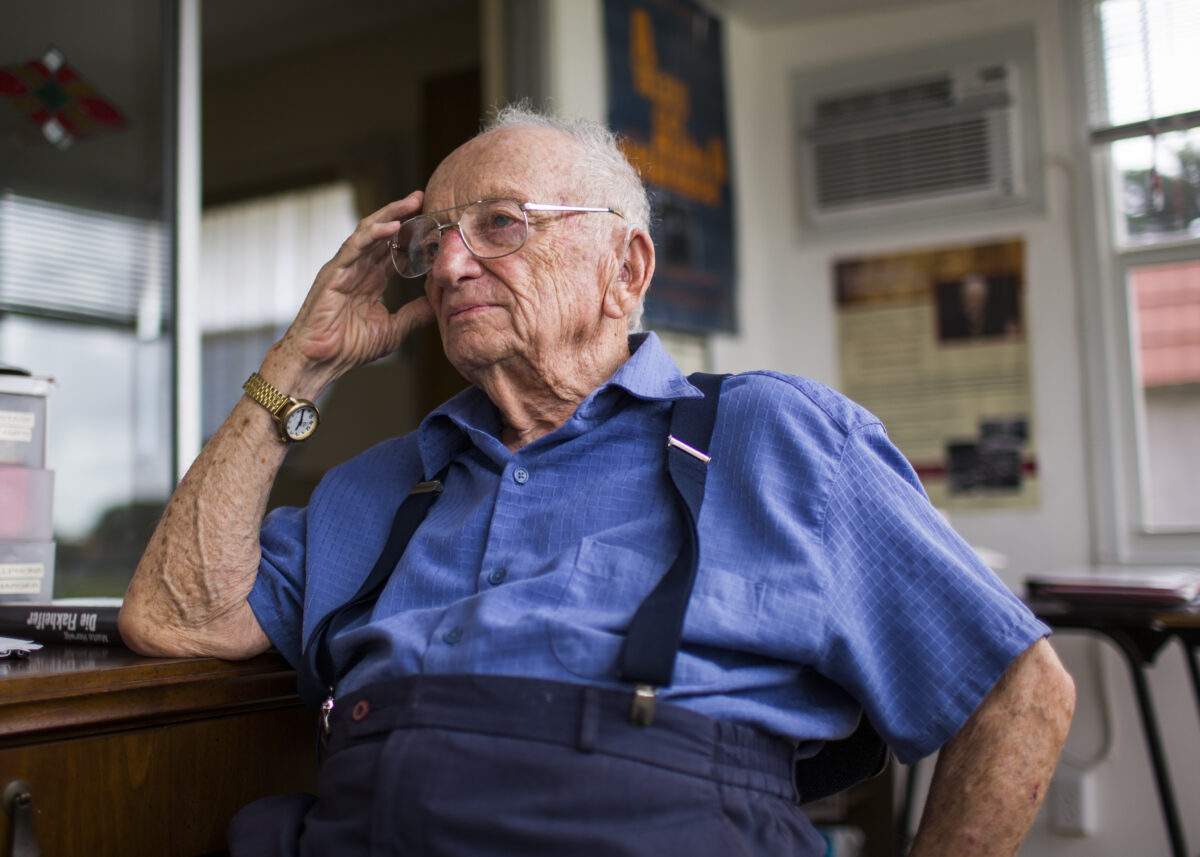Benjamin Ferencz, the last living prosecutor from the Nuremberg trials, died Friday, the United States Holocaust Memorial Museum in Washington confirmed. He was 103.
“Today the world lost a leader in the quest for justice for victims of genocide and related crimes,” the museum tweeted on April 7.
Born in 1920 into a Hungarian Jewish family in Transylvania, Romania, Ferencz emigrated with his family to the U.S. just 10 months later to escape rampant anti-Semitism. After graduating from Harvard Law School in 1943, Ferencz enlisted in the U.S. Army and was given the job of anti-aircraft artillery gunner.
Ferencz reminisced about the Army’s odd job placement in a 2016 interview with the Washington Post, noting, “In their typical [Army] brilliance, being a Harvard Law School graduate and an expert on war crimes, they assigned me to clean the latrines in the artillery and do every other filthy thing they could give me.”
“It took a while before it began to dawn upon them that perhaps I might be useful for something else,” he continued.
The diminutive-yet-outspoken Ferencz — who barely registered over 5 feet tall — eventually rose to the rank of sergeant as a member of Gen. George Patton’s Third Army. Action during the Normandy invasion followed — disembarking his landing craft at Omaha Beach, Ferencz found himself slugging through waist-deep water that came up to the knees of those around him — as did breaking through the Maginot and Siegfried lines, crossing the Rhine and bitter fighting in the Battle of the Bulge.

It was Ferencz’s last Army assignment, however, that would forever alter the trajectory of his life.
After an honorable discharge in 1945, Gen. Telford Taylor, then the chief prosecutor of the Nuremberg Trials, recruited Ferencz to return to Germany and work with a team of investigators tasked with uncovering the horrors of the Nazi regime.
Ferencz encountered the depths of human depravity while entrusted with gathering credible evidence of Nazi war crimes for the Army’s War Crimes Branch — the Germans maintained meticulous death registries at numerous camps.
“Camps like Buchenwald, Mauthausen, and Dachau are vividly imprinted in my mind’s eye,” Ferencz said in an interview with the United States Holocaust Memorial Museum. “Even today, when I close my eyes, I witness a deadly vision I can never forget.”
One of his investigators had discovered a trove of secret reports while rummaging through an annex of the German Foreign Ministry near Tempelhof Airport. The typed pages, bound in loose-leaf folders, had been sent daily by the Gestapo to top Nazi officials.
They provided full details of mass shootings of Jews, Gypsies, and other civilian “enemies” on the Eastern Front by Einsatzgruppen — SS extermination squads that followed the German army into the Soviet Union.
As Ferencz tallied up the numbers of victims listed in the reports, he was stunned.
“When I passed the figure of one million, I stopped adding,” he recalled. “That was quite enough for me.”
In the subsequent trial, the International Military Tribunal determined that nearly two million Jews were murdered by the Einsatzgruppen. But with the highest Nazi officials, including Hermann Göring and Rudolf Hess, already prosecuted, Britain, France and the Soviet Union moved on to other postwar concerns, according to the Washington Post. That left the U.S. to oversee any further prosecutions in Nuremberg.
Gen. Taylor, meanwhile, faced extreme pressure to wrap up tribunal proceedings, which included the prosecution of Nazi doctors who had conducted medical experiments on prisoners as well as the trove of evidence against the roving killers comprising the Einsatzgruppen.
At the time, Taylor’s staff was overextended and underequipped to take on another case.
“I start screaming,” Ferencz told 60 Minutes in 2017. “I said, ‘Look, I’ve got here mass murder, mass murder on an unparalleled scale.’ And [Taylor] said, ‘Can you do this in addition to your other work?’ And I said, ‘Sure.’ He said, ‘Okay.’ So, you do it.”
Ferencz, then just a 27-year-old without previous trial experience, became chief prosecutor in what is considered to be one of the most significant murder trials in history.
In theory, the young lawyer could have charged thousands with crimes. In reality, he was limited to the number of seats in the courtroom — 24.
Ferencz chose defendants based on rank and education. Of the original 24 selected for prosecution, one committed suicide before the trial and another died shortly after due to poor health, leaving Ferencz to prosecute 22 men for crimes against humanity.
During the trial, Ferencz became the first to use the word “genocide” — a term coined by Polish-Jewish refugee lawyer, Raphael Lemkin — in a court of law.
In his opening statement of United States of America v. Otto Ohlendorf et. al, Ferencz told the judge, “The killing of defenseless civilians during a war may be a war crime, but the same killings are part of another crime, a graver one, if you will, genocide, or a crime against humanity. This is the distinction we make in our pleading. It is real and most significant.”
“Death was their tool and life their toy,” he continued. “If these men be immune, then law has lost its meaning, and man must live in fear.”
All 22 men prosecuted by Ferencz were convicted. Most were sentenced to death. Defendant Emil Haussmann died prior to the trial.
In a discussion with historian Andrew Nagorski, Ferencz recalled, “I had 3,000 Einsatzgruppen members who every day went out and shot as many Jews as they could and Gypsies as well. I tried 22, I convicted 22, 14 were sentenced to death, four of them were actually executed, the rest of them got out after a few years.”
By 1958, the last of the surviving defendants were free men.
“The other 3,000 — nothing ever happened to them,” Ferencz added somberly. “Every day they had committed mass murder.”
After Nuremberg, Ferencz returned to New York with his wife, Gertrude, and spent several years tracking down and recovering the unclaimed heirlooms of Europe’s murdered Jews.
Motivated by what he saw during the Vietnam War, Ferencz quit his private practice and worked to establish an International Criminal Court with the power to investigate and charge individuals and nations of genocidal acts and war crimes.
The ICC was finally established in July 2002. Notably, the U.S. signed the treaty, but it was not ratified by Congress.
historynet magazines
Our 9 best-selling history titles feature in-depth storytelling and iconic imagery to engage and inform on the people, the wars, and the events that shaped America and the world.






